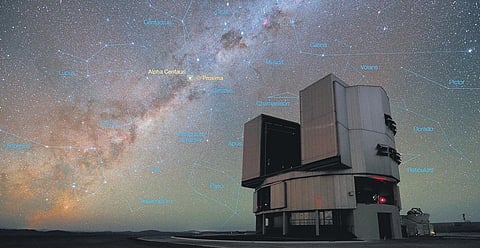

For ages, humankind has been eager to find an answer to the question — Is there life beyond Earth? In recent times, the discovery of unique exoplanets in habitable zones, with factors suitable to foster life, may answer just that
Humans have always been curious about finding signs of extraterrestrial life. Over 5,000 planets have been detected outside our Solar System after the first exoplanet was identified about 30 years ago. But the presence of life always seems to evade researchers. Detecting habitable Earth-like exoplanets has been challenging because of their small planet-star size, exotic atmospheres, extreme temperatures, and other conditions.
Traditionally, the search for life was focused primarily on rocky planets. However, currently, scientists are pinning their hopes on Hycean planets (ocean-covered worlds with hydrogen-rich atmospheres), where atmospheric conditions could be more conducive to sustain any biosignatures.
Scientists have identified a plethora of super-earths or mini-neptunes with plausible ocean covered surfaces. However, earlier investigations led them to believe that several factors, importantly the pressure and temperatures under a hydrogen-rich atmosphere there, would be too high to support life. But recent observations made with the JWST NIRISS and NIRSpec instruments found that under certain conditions, these planets could indeed support life.
Located in the habitable zone or ‘goldilocks zone' of the cool red dwarf K2-18, in the constellation Leo, approximately 124 light years away from Earth, scientists have come across a candidate of Hycean world, 'K2-18b'. In 2015, the Kepler space telescope was able to discover K2-18b, which has 8.6 times the Earth’s mass and 2.6 times its radius. One year here lasts only 33 Earth days, which means it is a lot closer to its red dwarf, than Earth is to its Sun. But, K2-18 is cooler and smaller.
It is an M-dwarf, characterised by its relatively low mass and luminosity, making it faint compared to its larger counterparts, such as the G-type star like our Sun. Due to the lower luminosity of M-dwarfs, their habitable zones are much closer which could potentially allow K2-18b to host life.
One of the most important features required for a planet to support life is a stable star. M-dwarfs like K2-18 are a perfect candidate as they are quiet stars with reduced stellar activity, reducing the likelihood of destructive events such as solar flares, which could strip away a planet’s atmosphere or harm potential forms of life.
Some famous examples of exoplanets orbiting M-dwarfs are 'Proxima Centauri b' and 'TRAPPIST-1' system, which are also intriguing candidates for further study. K2-18b is just one among a handful of exoplanets which could potentially be hosting life. In 2019, Hubble Space Telescope's mirrors were pointing at K2-18b, allowing to make more discoveries. Research was conducted, and data hinted that K2-18b could be the only exoplanet with water in its atmosphere.
LIFE ON JUPITER’S MOON?
Europa, one of the four largest moons orbiting Jupiter, is considered one of the most promising habitable environments in our Solar System. It is believed to have all the ingredients needed to sustain life as we know it, including liquid water, salt deposits, and magnesium. Though Europa’s surface is blasted by radiation from Jupiter, which makes it uninhabitable for life on the surface, the influence of radiation on the ice on its surface will help release oxygen, the main component in its atmosphere. If this oxygen somehow finds a way under the ice on Europa’s crust, it can become the fuel required for life to develop even if it is just bacteria. It is also possible that Europa may have anaerobic life forms which do not require oxygen. Astronomers have also noticed hydrothermal breakouts on its surface. Life may be found around these hydrothermal zones just like it is observed in the depths of the Earth’s oceans. To determine if the icy moon can support life, NASA has scheduled to launch the Europa Clipper mission on October 6, 2024. The mission will study Europa’s ice shell, subsurface ocean, composition and geology.
HABITABLE EXOPLANETS CATALOG
The cosmos is teeming with potential habitable exoplanets and exomoons. In order to keep track of these exoplanets, the Planetary Habitability Laboratory at the University of Puerto Rico at Arecibo maintains a Habitable Exoplanet Catalog. This is a database of potentially habitable worlds discovered by ground and space telescopes in the last decade. The exoplanet data comes from the NASA Exoplanet Archive, and includes planets up to 2.5 Earth radii or 10 Earth masses orbiting within the optimistic stellar habitable zone to be as inclusive as possible. As of January 5, 2023, the catalog lists a total of 63 potential habitable worlds. The catalog offers details about each planet, including its name, classification, mass, radius, average stellar flux, estimated surface temperature, orbital period, distance from the Earth, and Earth SImilarity Index (ESI). The conservative sample includes those that are most likely to be rocky up to 1.6 Earth radii or 3 Earth masses, while the optimistic sample includes those that are more likely to maintain surface liquid water.
BREAKTHROUGH STARSHOT: TO INFINITY AND BEYOND
An international team of astronomers has found signs that a habitable planet may be lurking in the Alpha Centauri system. Alpha Centauri is a triple-star system consisting of two stars, Alpha Centauri A and B, and a red dwarf, Proxima Centauri, that is known to have at least two exoplanets, one of which appears to be similar to Earth. It is the closest star to our solar system, located at a distance of about 4.37 light years away. The new TOLIMAN space telescope mission will look for habitable planets in the Alpha Centauri system. Using our current technology, a trip to Proxima Centauri would take about 78,000 years. But projects like Breakthrough Starshot would give a great boost to development of new methods of space propulsion and new technologies for miniaturisation of cameras and other components.